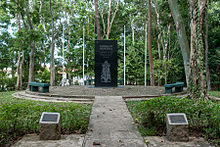Sandakan Memorial Park
The Sandakan Memorial Park or ( mal. ) Tanah Peringatan Sandakan is a memorial on the site of the former prisoner of war camp Sandakan in the Malaysian state of Sabah . The memorial is dedicated to the memory of the prisoners of war in the camp in Sandakan who died here, during the death marches and in Ranau . It also pays tribute to the suffering and sacrifice of the local population.
location
The memorial is about 1.5 kilometers southwest of today 's Sandakan Airport . The memorial occupies part of the former camp of the Australian B Force .
history
Due to the initially successful course of the war for the Japanese, large numbers of Allied soldiers were distributed as prisoners of war to various camp facilities in the Pacific region. In July 1942, nearly 1,500 Australian prisoners of war were transferred from Singapore to Sandakan to build a military airfield there. In 1943 more than 770 British and another 500 Australian “ POWs ” followed.
At the height of occupancy in 1943, the camp housed around 2,500 prisoners of war. In January 1945, the first of the three " Death Marches of Sandakan " started from here .
In 1986, a memorial stone was erected on the abandoned site, honoring the merits of Captain Lionel Matthews and the Sandakan underground movement and also commemorating the six survivors of the death marches.
An agreement between the Government of Sabah State, the Government of Australia, the Veterans Association "Returned & Services League of Australia" and the Sandakan City Council in 1995 paved the way for the memorial to be built. The Australian government had the pavilion and obelisk with the memorial place built and restored the remains of the technical facilities of the camp, i.e. the excavator, steam generator and generator. The ceremonial opening of the memorial took place on March 18, 1999.
Stations of the memorial
The memorial is divided into six stations, which are connected by a circular path.
Excavator
The excavator was used to build the airport. While it was being repaired, it was sabotaged by an Australian prisoner of war. It was never used again.
Steam generator and generator
The steam generator and part of the generator that went with it belonged to the camp's power station. The E-Werk was built before the Japanese occupation of Sabah. The wood-fired steam engine powered the generator, which in turn produced electricity with a voltage of 110 volts, which was used to light the camp and its fencing.
The electrical works also played an important role in running the secret transmitter controlled by the camp's underground movement. From 1942 until its discovery in July 1943, the voltage was secretly increased in the evening hours in order to supply the transmitter with sufficient voltage.
The big tree
"The Great Tree" (The Big Tree) - a huge specimen of a Mengarisbaumes (Koompassia excelsa) - originally stood where the memorial obelisk is placed today. Due to its size, it was the dominant structure of the prisoner of war camp. Shortly after the end of the war, it was destroyed by fire. A new mengaris tree was planted on April 25, 2008 near the entrance to the park.
Food magazine and kitchen
The Japanese quartermaster ran a food depot and kitchen for the Japanese near storage area 1. A concrete foundation and water reservoir have been preserved from this facility.
Main entrance and access road
The main entrance to camp area 1 used to be on the east side of the memorial. The remains of a road lead to the left to the airport and to the right to mile 8 on the road from Sandakan to Ranau. All three marches to Ranau started from here.
Memorial pavilion
The Sandakan Commemorative Pavilion was opened on March 18, 1999 by the Australian Minister for Veterans Affairs, Bruce Scott. It contains a permanent exhibition on the POW camp and the death marches in English and Malay.
Memorial
The actual "Sandakan Memorial" is a black stele on a circular, paved square about ten meters in diameter. It bears the inscription:
Sandakan Memorial
In Remembrance Of All Those
Who Suffered and Died Here,
On The Death Marches
And At Ranau
Others
All remains of prisoners of war found on the site during post-war investigations were transferred to the central war cemetery in Labuan . The identified dead were buried there in graves marked by name, while the names of the others were listed on commemorative plaques in Labuan and Singapore.
POW route
The memorial is the first stop on the “POW Route” on which the prisoners of war marched in the area during the three death marches. The route begins in Sandakan and ends at the “ Last POW Camp” near Ranau. The stations of the route are marked with a sign.
literature
- Australian Government, Office of Australian War Graves: SANDAKAN MEMORIAL PARK , Department of Veterans' Affairs, Canberra, 2006
Web links
Individual evidence
- ↑ a b Information on the board "The 1986 Monument", put up by the Australian government. As of August 2012
Coordinates: 5 ° 53 '18.7 " N , 118 ° 2' 49.9" E




